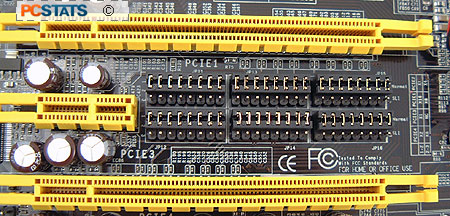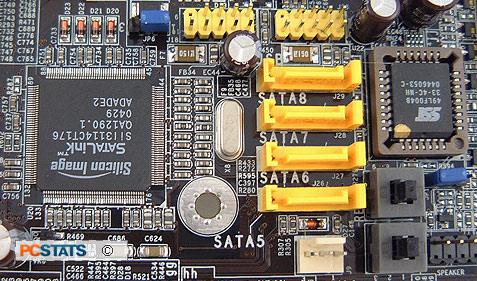As
I'm sure you've noticed, between the two PCI Express x16
slots are a series of manual jumpers. The six sets of jumpers must all be set
to the same side depending on whether you want to enable SLI or not. This is
not the most efficient method and I would have preferred the switch
type method most other manufacturers employ.
Asus
has just released its A8N-SLI Premium which uses the Pericom Semiconductor's
PCI Express Switch IC. perhaps DFI will implement something like this on future
revisions of the LANParty NF4 SLI-DR.

To change
the jumpers, DFI thoughtfully include a handy jumper removal tool which is much
easier than using your fingers. Because of their small size, a few spare sets
of jumpers are tossed in just in case you happen to lose one. Trust me, it's easier done than
you think... A small instruction diagram between the PCI Express x16 slots just to the
right of the jumpers indicates the settings, as does the manual.
The additional PCIe x1 and
x4 slots present on the board use an interesting scheme to
divide the additional 4 lanes of PCI Express between themselves.
When the SLI switch is 'off' and a full 16 lanes are devoted to the top PCIe x16
slot for one video card, both the x1 and x4 slots each use a single lane of
PCI Express bandwidth, while the second PCIe x16 slot gets the last two
lanes. When SLI is enabled, the two PCIe x16 slots get 8 lanes each, the
x1 slot between them is disabled and the top PCIe x4 slot gets a full four
lanes. Got all that?
A PCI Silicon Image
Sil3114 Serial ATA RAID controller (generation one) is present on the DFI
LANParty NF4 SLI-DR to add extra SATA drive support. By default this
controller supports four Serial ATA drives and can also run RAID modes 0, 1, 0+1 and 5. Too
bad it has to pass through the PCI bus, but with nothing else big running on it
(other than IEEE 1394), there shouldn't be much of a bottleneck.

At the
bottom right hand corner of the motherboard, DFI has integrated power and
reset switches. This is a great feature since many enthusiasts in the
middle of tweaking a system don't even bother to install the gear into
a case. Using the buttons is easier than shorting two pins with a jumper, or pencil.
